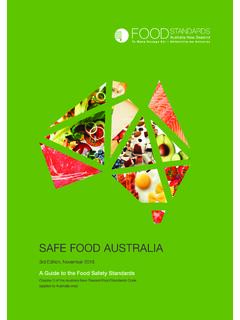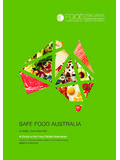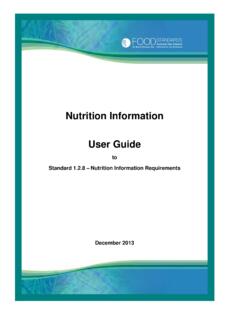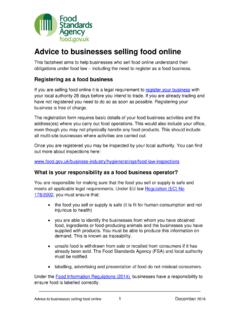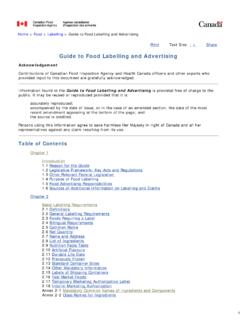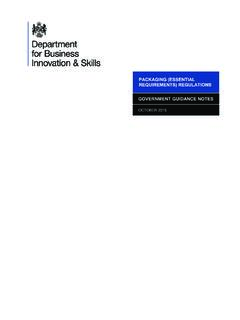Transcription of Appendix 3: Limits for food processes - Food Standards
1 158 APPENDICESA guide TO THE food SAFETY Standards THIRD EDITION NOVEMBER 2016 food Standards AUSTRALIA NEW ZEALAND SAFE food AUSTRALIAFOOD Standards AUSTRALIA NEW ZEALAND SAFE food AUSTRALIA3 Appendix 3 Appendix 3: Limits for food processesThe following table is intended as a quick guide to Limits to be achieved for some food processes based on the control of commonly associated foodborne pathogens1. The nature of the food and the full process used to produce it, as well as how it is packaged and stored should be taken into limitCommentAcidificationpH < the growth of pathogenic microorganisms such as Clostridium botulinum and Bacillus Fruit and Vegetables specifies that fruit and vegetables in brine, oil, vinegar or water (other than commercially canned) must not have a pH greater than food Authority s food Safety Guidelines for the Preparation and Display of Sushi provides guidance on the acidification of sushi the growth of food Authority s food Safety Guidelines for the Preparation of Raw Egg Products provides guidance on the acidification of raw egg products such as mayonnaise and low-acid food (pH > )121 C for 3 mins (or equivalent)Required for the elimination of C.
2 Botulinum spores (12 D process for proteolytic strains).ConfitSee sous temperature of at least 75 C for poultryRecommended to eliminate Salmonella and temperature of at least 75 C for stuffed, rolled, reformed or minced meat products6D heat process for Listeria Meat and Livestock Australia s Guidelines for the Safe Manufacture of NEW ZEALAND food Standards CODE CHAPTER 3 (AUSTRALIA ONLY)APPENDICESFOOD Standards AUSTRALIA NEW ZEALAND SAFE food AUSTRALIA3 Appendix 3 ProcessCritical limitCommentCook/Chill2 The combination of heat treatment, rapid chilling (to 5 C) and packaging should ensure the product is safe for the given shelf Cox and Bauler s Cook Chill For Foodservice and Manufacturing: Guidelines for Safe Production, Storage and Distribution (Cox & Bauler, 2008) or PrimeSafe s Shelf Life and labelling requirements for Meat process of 70 C for 2 minutes or heating to 75 C (for refrigerated food with a short shelf life < 10 days)6D heat process for Listeria process of 90 C for 10 minutes (or equivalent) for refrigerated foods with an extended shelf life >10 days6D heat process for non-proteolytic C.
3 To 3 CThe growth of non-proteolytic C. botulinum is prevented at 3 C and below. This temperature may be required for storage of extended shelf life cook chill foods where processing and package conditions can support C. botulinum C to 21 C in 2 hrs, 21 C to 5 C in 4 hrsAs per Standard subclause 7(3).Alternative cooling Limits for cooked bulk processed meat products are provided in Appendix < of pathogenic bacteria controlled (aw limit of growth of Staphylococcus aureus in salt conditions).Standard Meat and Meat Products requires food that is sold as dried meat to have a water activity of no more than by most xerophilic fungi prevented at aw guide TO THE food SAFETY Standards THIRD EDITION NOVEMBER 2016 food Standards AUSTRALIA NEW ZEALAND SAFE food AUSTRALIAFOOD Standards AUSTRALIA NEW ZEALAND SAFE food AUSTRALIA3 Appendix 3 ProcessCritical limitCommentFermentingpH Limits will depend on the particular food and starter culture used.
4 May need to be combined with other hurdles, such as aw or refrigeration to achieve required process may use bacteria, yeasts or moulds. Starter culture used should result in adequate production of acid to prevent growth of other organisms Fermented Milk Products requires the pH of fermented milk or yoghurt to be for uncooked comminuted fermented meat are specified in Standard Primary Production and Processing Standard for (thermal)Temperature/time Limits depend on the food and target temperature and time equivalents for a 6D reduction of non-proteolytic C. botulinum and for L. monocytogenes are provided in Cox and Bauler (2008).72 C for 15 sec (or equivalent) for milkSee Standard Primary Production and Processing Standard for Dairy C for minutes for whole egg pulp60 C for minutes for liquid egg yolks55 C for minutes for liquid egg whiteSee Standard Primary Production and Processing Standard for Eggs and Egg 5 CSous vide55 C minimum water temperatureEffective pasteurisation or cooking is achieved by holding food at relatively low temperatures for an optimum minimum temperature of 55 C is recommended to prevent growth of Clostridium NSW food Authority s Sous Vide food Safety Precautions for NEW ZEALAND food Standards CODE CHAPTER 3 (AUSTRALIA ONLY)
5 APPENDICESFOOD Standards AUSTRALIA NEW ZEALAND SAFE food AUSTRALIA3 Appendix 3 ProcessCritical limitCommentSugar concentrationaw < sugar foods include jams, confectionery and fruit aw of inhibits mould and MAP packingAs per validated process details will depend on the above for cook chill materials should have good gas barrier = water activity1. Factors affecting pathogen growth, survival and toxin production are described in the International Commission on Microbiological Specifications for Foods (ICMSF 1996).2. Useful practical guidance for controlling foodborne pathogens, particularly in cook-chill foods, is provided in Cox and Bauler Resources and References section for full reference information.
